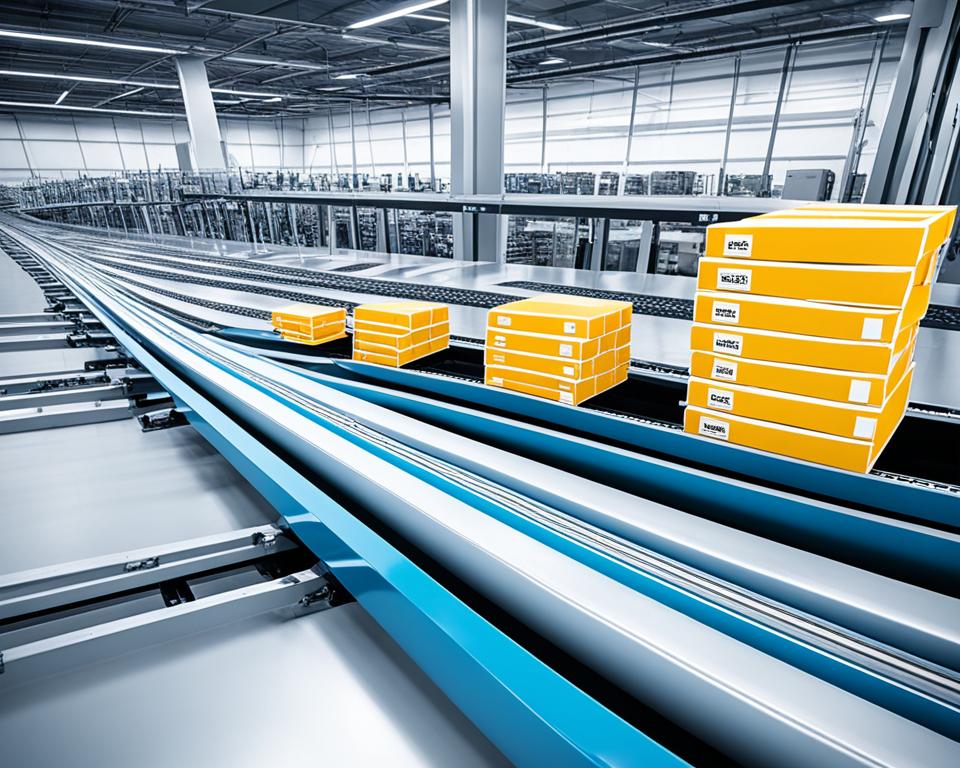Have you ever thought about how top companies make their workflows smooth and efficient? In today’s fast-paced world, using tools like SAP GP is key for any business wanting to succeed. I want to show how SAP GP can change your business for the better, help you make better decisions, and manage resources better. This will highlight how SAP GP can boost efficiency and innovation in your company.
Key Takeaways
- SAP GP offers effective solutions for streamlining business processes.
- Maximizing operational efficiency is essential for maintaining competitiveness.
- Integrating SAP GP promotes agile enterprise capabilities.
- Stronger decision-making can be achieved through optimized workflows.
- Resource management improves significantly with SAP GP implementation.
Understanding SAP GP and Its Role in Business Process Optimization
SAP GP, or Guided Procedures, is key for businesses wanting to improve their processes. It gives a clear structure for automating and managing complex workflows. This makes complex tasks simpler, letting employees easily follow and complete them.
Adding SAP GP boosts how well operations run. It cuts down on mistakes that happen in complex tasks. With guided steps, companies make sure workers stick to the best methods. This leads to better quality and more work getting done.
Using SAP GP also means using data to keep improving. Companies can look at how they’re doing and find ways to get better. This helps create a culture of always getting better. SAP GP helps businesses change and adapt quickly, making them more agile and ready to respond.
| Feature | Description | Benefits |
|---|---|---|
| Automation | Streamlines complex workflows | Increases speed and reduces manual intervention |
| Guided Procedures | Offers step-by-step instructions | Minimizes errors and enhances user compliance |
| Data-Driven Insights | Analyses performance metrics | Facilitates continuous process improvement |
The Importance of Workflow Optimization in Today’s Enterprises
In today’s fast-paced business world, workflow optimization is key to boosting operational efficiency and enterprise productivity. Companies must streamline their processes to quickly meet new demands. This makes them more responsive and agile.
Using lean methodologies is a smart move. It cuts down on waste, saving money and making processes better. This boosts operational efficiency and encourages a culture of constant improvement. Happy employees come from well-run workflows, which means better customer service.

- Streamlining processes enhances quick response to market shifts.
- Lean methods reduce operational waste.
- Optimized workflows improve employee engagement.
- Higher productivity means happier customers.
Success comes from combining these strategies well. By focusing on workflow optimization, companies can see big gains in productivity. This puts them ahead in the market. It also leads to cost savings and growth over time.
SAP GP: Guided Procedures for Enhanced Efficiency
In today’s fast-paced business world, making things more efficient is key. SAP GP offers a great way to do this with its guided procedures. These steps guide users through tasks, making things run smoother and more consistently.
What Are Guided Procedures?
Guided procedures in SAP GP make tasks easier to follow. They make sure everyone does things the right way, reducing mistakes. By breaking tasks into simple steps, they make it easier for users to get involved and complete projects smoothly.
The Benefits of Implementing Guided Procedures
Using guided procedures in SAP GP has big benefits for businesses. The main advantages are:
- Improved user training and knowledge retention.
- Faster onboarding times for new employees.
- Increased overall efficiency, especially in complex situations.
- Enhanced compliance with company standards and laws.
With these benefits, SAP GP’s guided procedures are a big help in making business operations smoother.
Intelligent Process Automation: Transforming Operations
Intelligent process automation (IPA) is changing how we work. It uses artificial intelligence and machine learning to make things more efficient and cheaper. Companies that use this tech see a big boost in how much they can do.
Key Features of Intelligent Process Automation
The main features of intelligent process automation are:
- Real-time data analysis helps make quick decisions.
- Predictive analytics lets companies see what’s coming and plan for it.
- Automating simple tasks lets workers focus on more complex tasks.
Integrating Intelligent Process Automation with SAP GP
Combining intelligent process automation with SAP GP makes things run smoother. This mix brings together smart analytics and automation. It helps businesses quickly adjust to new market trends.
By doing this, companies can make their processes better and stay ahead. For more tips on improving skills in these areas, check out mastering ABAP Object-Oriented Programming.

Digital Process Guidance: Elevating User Experience
Digital process guidance changes how users interact with apps. It gives real-time support, cutting down on confusion and boosting the user experience. Tools like tooltips and context-aware help give users the info they need right away.
Adding digital process guidance to SAP GP helps companies a lot. It makes it easy for users to get through complex systems. With step-by-step guides, users can pick up new processes quickly, making it easier to learn new software.
Looking into ways to make user experience better, I see that SAP GP’s visual aids and guidance really help. This live support keeps users productive and cuts down on frustration. Using these features leads to happier users and better performance.
| Guidance Feature | Description | Benefits |
|---|---|---|
| Tooltips | Short, informative messages that appear when users hover over an element. | Improves understanding of features without disrupting workflow. |
| Context-aware Help | Assistance tailored to the specific area of the application being accessed. | Increases efficiency by providing relevant guidance when needed. |
| Step-by-Step Instructions | Detailed guides that walk users through complex processes. | Enhances learning by breaking down tasks into manageable steps. |
Adding digital process guidance to SAP GP is a big chance to make user experience better. It makes tasks simpler and creates a happier work environment.
The Impact of SAP Intelligent Enterprise on Business Success
The SAP Intelligent Enterprise framework is key to business success. It focuses on advanced analytics, industry cloud apps, and the SAP Business Technology Platform. This helps companies use real-time insights and make data-driven decisions.
Core Components of the SAP Intelligent Enterprise
This framework’s core components help businesses run smoother and more efficiently. The main parts are:
- Advanced Analytics: Helps companies make smart moves with data insights.
- Industry Cloud Applications: Offers solutions that fit specific industry needs.
- SAP Business Technology Platform: Connects different business processes together.
Benefits for Different Business Sectors
Every sector gets its own set of benefits from the SAP Intelligent Enterprise. For instance:
| Business Sector | Key Benefits |
|---|---|
| Manufacturing | Boosts automation and production efficiency. |
| Finance | Improves risk management with timely data analysis. |
| Retail | Creates personalized customer experiences with data-driven strategies. |
Enhancing Enterprise Productivity with SAP GP
Using SAP GP helps businesses work better. It makes tasks faster and more accurate. This means teams can focus on important work, not just the basics.
Companies use SAP GP to make everyday tasks easier. For example, buying things becomes smoother, which helps work better with suppliers. They make better decisions faster. Cloud technology gives teams real-time data, sparking new ideas.
In India, SAP Ariba has helped many companies work better. They use smart buying and online ordering to save money and be more flexible. Moving to digital keeps them ahead in a fast-changing market. For more stories of success, check out this resource.
| Key Aspects | SAP GP Benefits | Efficiency Improvements |
|---|---|---|
| Streamlined Workflows | Faster task execution | Reduced operational delays |
| Guided Procedures | Enhanced user experience | Increased accuracy in tasks |
| Cloud Integration | Real-time data access | Informed decision-making capabilities |
Using SAP GP leads to big changes in how businesses work. It makes them more productive and successful in many areas.
Operational Excellence Solutions with SAP GP
For businesses to succeed, achieving operational excellence is key. SAP GP solutions help streamline processes and keep performance high. A strategic plan that includes planning and measuring success boosts operational skills.
Strategies for Achieving Operational Excellence
Using SAP GP solutions means following key strategies for excellence:
- Regular performance reviews to spot areas to improve.
- Setting key performance indicators (KPIs) that match business goals.
- Training employees to work more efficiently.
- Creating a culture that always looks for ways to get better.
These strategies help businesses make lasting improvements. Focusing on excellence boosts efficiency and quality standards.
Measuring Success in Operational Excellence
It’s important to measure success to see where to improve. Using strong metrics helps track performance. Metrics can include:
- Lower operational costs.
- Higher customer satisfaction scores.
- More output with better use of resources.
By watching these metrics, I can spot trends and make smart choices. For more on managing these metrics well, check out the ABAP Dictionary and its role in improving data and system performance.

Smart Manufacturing and Its Connection to SAP GP
Smart manufacturing is the future of making things. It uses advanced tech to make processes better. With smart manufacturing, my production places run smoothly. SAP GP plays a big part in this by making sure all steps in making things are done right.
SAP GP helps by making data available in real time. This helps me make smart choices and talk better with my team. It leads to better managing of stock, making things faster, and making my factory more efficient.
When the competition is tough, using smart manufacturing with SAP GP is key. It opens doors to new ideas that cut waste and improve quality. This way, my work is not just efficient but also meets today’s high standards.
Here’s a summary of the benefits of combining smart manufacturing with SAP GP:
| Benefit | Description |
|---|---|
| Increased Efficiency | Streamlined processes and reduced downtime enhance production output. |
| Real-Time Insights | Immediate access to data improves decision-making and operational transparency. |
| Quality Improvement | Consistent procedures lead to higher standards and less variability in products. |
| Inventory Optimization | Efficient tracking minimizes excess stock and reduces carrying costs. |
Leveraging Industry 4.0 Technologies with SAP GP
Industry 4.0 is changing how manufacturing and technology work together. Technologies like the Internet of Things (IoT), artificial intelligence (AI), and cloud computing are key. They help make operations better and help companies quickly adapt to new market trends. Using these with SAP GP speeds up the move to digital transformation.
SAP GP is a great tool for making processes smoother and adding Industry 4.0 tech. It lets companies share data in real-time and automate tasks. This means they can understand their operations better and make smart choices to boost productivity. For example, IoT devices help keep an eye on things all the time. This lets companies fix problems before they get worse.

- Improved Responsiveness: Companies can quickly meet customer needs, making customers happier.
- Real-Time Analytics: Having up-to-date data helps in making quick, informed decisions.
- Innovative Solutions: The mix of tech leads to new ideas for products and services.
Using SAP GP with Industry 4.0 tech puts companies ahead in innovation. This approach helps them deal with the digital change smoothly. It also makes their business more flexible and quick to respond.
Process Digitalization: The Future of Business Operations
Process digitalization is changing the way businesses work today. It means using digital tech in every part of operations. This big change helps companies work better and add more value.
By going digital, companies can make their work flow smoother. They can see things more clearly and find new ways to innovate.
What Is Process Digitalization?
It’s about moving from old ways to new digital methods in all business areas. This change makes companies work more efficiently. It also helps them quickly adapt to market changes.
This leads to a strong way of working that keeps evolving.
The Role of SAP GP in Digital Transformation
SAP GP plays a key role in this digital change. It gives companies the tools to make their processes digital and efficient. With SAP GP, companies can be quick and ready for the future of business.
Case Studies: Successful Implementations of SAP GP
Looking into SAP GP case studies shows how companies have made the software a big part of their work. These stories are very useful, showing implementation success and how the software changed things for the better in different fields.
A big company in manufacturing saw a big change after using SAP GP. They got 30% more efficient in just six months. This was thanks to better workflows and less paperwork.
In the healthcare world, another group used SAP GP to make things more accurate. They cut down on compliance problems by 40%. This shows how the software helps with being more careful and precise.
| Industry | Implementation Success | Operational Improvement |
|---|---|---|
| Manufacturing | 30% increase in efficiency | Streamlined workflows |
| Healthcare | 40% decrease in compliance issues | Enhanced accuracy |
These SAP GP stories show the real benefits and share best practices for others to follow. They show how businesses can get more innovative and line up with their goals with the right procedures.

Best Practices for Implementing SAP GP in Your Organization
When looking at SAP GP implementation, a strategic approach is key. It’s important to engage stakeholders, plan well, and get continuous feedback. Offering thorough training helps everyone understand and use the system well.
Good change management strategies help with resistance and make the transition smoother. Tailoring procedures to fit your operations improves the user experience and efficiency. Regular performance checks let you adjust and improve your implementation.
The following table outlines key best practices associated with SAP GP implementation:
| Best Practice | Description |
|---|---|
| Stakeholder Engagement | Involve key stakeholders early to gather insights and build support for the initiative. |
| Comprehensive Training | Offer extensive training programs tailored to different user roles within the organization. |
| Change Management | Implement strategies to effectively manage changes and reduce resistance among staff. |
| Customization of Procedures | Adjust guided procedures to align with specific operational requirements for improved efficiency. |
| Regular Performance Assessments | Continuously evaluate performance metrics to enhance implementation strategies and outcomes. |
Using resources like essential tips for mastering ABAP reports can help improve reporting. With strong strategies, SAP GP can meet your long-term goals.
Overcoming Challenges When Adopting SAP GP
Adopting SAP GP brings big benefits, but companies face many challenges. These include resistance to change, not enough training, and complex integration. It’s key to tackle these implementation obstacles for a smooth shift.
Common Challenges and How to Tackle Them
To beat the challenges of SAP GP adoption, having a plan is vital. Here are some common issues and how to fix them:
- Resistance to Change:
- Open communication helps explain SAP GP’s benefits.
- Let team members help decide to build ownership.
- Insufficient Training:
- Offer ongoing training that meets user needs.
- Make training resources and support easy to find.
- Integration Complexities:
- Roll out SAP GP in phases to ease integration with current systems.
- Use expert consultants for smoother transitions.
By tackling these challenges with strategic steps, companies can boost their SAP GP success. This leads to better efficiency and productivity.
| Challenge | Impact | Solution |
|---|---|---|
| Resistance to Change | Lower employee morale and productivity | Engage employees in the process |
| Insufficient Training | Poor user adoption rates | Provide comprehensive training |
| Integration Complexities | Disrupted workflows | Implement phased rollouts |
Conclusion
This article has shown how SAP GP helps businesses improve their work flow. It makes processes smoother, leading to more work getting done. SAP GP uses smart automation and digital advice to make things better now and prepare for the future.
Using SAP GP also helps companies work better together, improve their relationships with suppliers, and make quick, smart decisions. This is key for any business wanting to do well. As things change, using tools like SAP GP will give companies a big edge and help them grow.
Looking ahead, it’s clear that using strong technology is a must. For companies ready to move forward, understanding how systems work together is crucial. Learning about how Ariba and SAP ERP work together can help a lot. For more on using SAP GP, check out this insightful read on streamlined success through Ariba.
FAQ
What is SAP GP and how does it optimize business processes?
SAP GP, or Guided Procedures, helps streamline business processes. It offers a structured framework for complex workflows. This makes operations more efficient by breaking tasks into simple steps. It also reduces errors and speeds up decision-making.
How can workflow optimization enhance enterprise productivity?
Workflow optimization boosts productivity by making businesses quick to adapt to changes and cutting waste. It leads to happier employees, better team collaboration, and improved customer service. This results in higher customer satisfaction and loyalty.
What role does Intelligent Process Automation play in enhancing operations?
Intelligent Process Automation (IPA) uses AI and machine learning to make operations smoother. It automates repetitive tasks and analyzes data in real-time. By combining IPA with SAP GP, companies can make their processes more agile and efficient.
What is Digital Process Guidance and how does it benefit users?
Digital Process Guidance offers real-time support in applications. It helps users with tooltips and step-by-step guides. This makes processes easier to follow, cuts learning time, and keeps productivity high.
How does the SAP Intelligent Enterprise model influence business success?
The SAP Intelligent Enterprise model uses advanced analytics and cloud apps for real-time insights. It helps different sectors make better decisions and innovate. This keeps companies ahead in the market.
What strategies can organizations adopt to achieve operational excellence with SAP GP?
To excel, companies should regularly review performance and set KPIs that match their goals. SAP GP provides tools to spot and fix inefficiencies. This ensures high standards in all operations.
How is Smart Manufacturing connected to SAP GP?
Smart Manufacturing aims for top efficiency through technology. SAP GP helps by standardizing workflows and improving data visibility. This leads to better inventory management and faster production.
In what ways can Industry 4.0 technologies be leveraged alongside SAP GP?
Industry 4.0 tech like IoT and AI boosts SAP GP’s features for smarter operations and real-time analytics. This helps companies meet consumer needs better and innovate for operational improvements.
What is process digitalization, and how does SAP GP support it?
Process digitalization uses digital tech to make business operations more efficient. SAP GP is key in this by digitizing workflows and improving data visibility. This helps companies adapt quickly to market changes.
Can you provide examples of successful SAP GP implementations?
Many case studies show how SAP GP has helped companies improve efficiency and cut costs. These examples offer insights into best practices and the big impact of guided procedures on business performance.
What best practices should I follow when implementing SAP GP?
For a successful SAP GP implementation, plan strategically and engage stakeholders. Key steps include thorough training, effective change management, and customizing procedures for your operations.
What challenges may arise during SAP GP adoption, and how can I address them?
Challenges like resistance to change and integration issues may come up. Overcome these by offering ongoing training, engaging stakeholders, and rolling out changes in phases. This helps increase adoption and ensures a smooth implementation.








